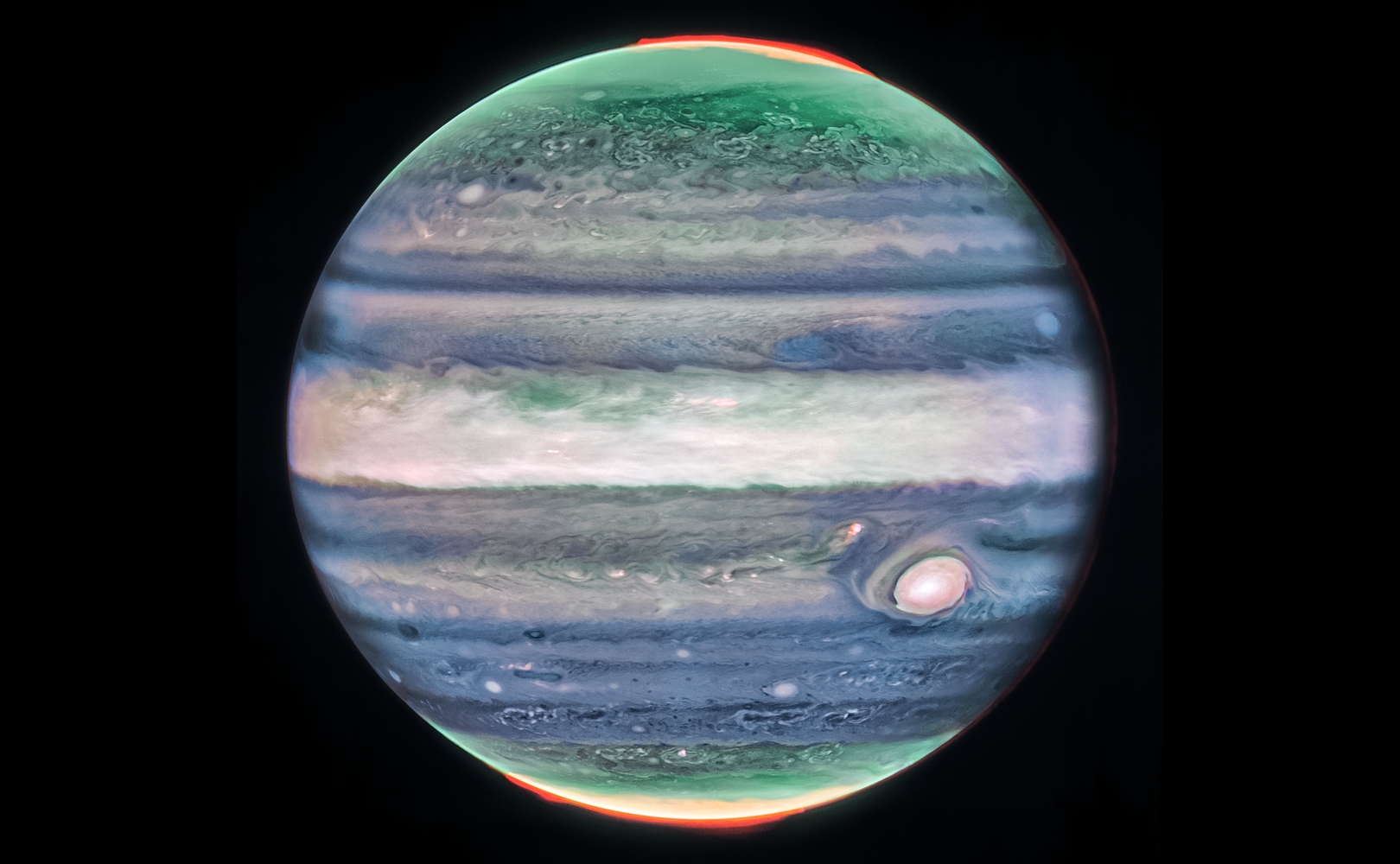Jupiter, the largest planet in the solar system, continues to amaze, and so does the Webb Telescope. Infrared images show something that has never been observed before. In addition, the coming weeks are the perfect time to spot this planet in your backyard.
Jupiter was the first planet in the solar system that the Webb Space Telescope looked at as it prepared for regular observations. Experimental images of Jupiter were already impressive, but the telescope and its NIRCam instrument outdid themselves. The observations were made in July 2022, but the results of the data analysis have only now been revealed. It is accompanied, as always, by a beautiful image of Jupiter.
Burning plumes and something unusual at the center of Jupiter’s disk
The colors of the planet in the image are of course unnatural, but this is a result of the observation ranges being different from those seen, and the colors were chosen to better reflect the nature of the visible details. And what we see in the picture. The north and south poles appear to be on fire, and this is exactly Jupiter’s aurora borealis.
The bright spots and lines visible on the cloud bands are actually the top layers of clouds that accompany convective storms on Jupiter. According to the image description, the dark bands that are particularly visible in Jupiter’s northern hemisphere are areas where cloud cover is relatively low and sparse.
But these weren’t the superficial details that interested astronomers most in Webb’s latest images. This is something only Webb could see, even though we’ve been monitoring the planet closely for decades, and it has been seen up close not only by the passing Voyagers and Cassini-Huygens rovers, but also by the Juno probe, which is still exploring the Jupiter system.
That striking detail is the jet stream, which now appears as a distinct line above the planet’s equator in near-infrared images but is farther away than before. Previous observations suggested they might exist, but because they reached deeper into the clouds, evidence of jet streams was fleeting. Now, as astronomers observing Jupiter through Webb point out, these details are so clear that their characteristics can be well defined.
The jet streams occur 20 to 35 kilometers above the main cloud cover in Jupiter’s lower stratosphere, and reach speeds of up to 515 kilometers per hour. NASA compares this speed to twice the wind speed of an F5 hurricane (theoretically the strongest on record). In Poland, tornadoes blowing at speeds of 150 kilometers per hour are considered to have serious consequences.
Webb figured that out, but Hubble was helpful in getting it all right in his head
The jet structure observed by Webb, which is associated with the jet stream, is 4,800 kilometers long. That’s a lot for us, but since Jupiter’s circumference is 439,264 kilometers (11 times larger than Earth), it’s small in Jupiter’s image. Jupiter is monitored approximately every 10 hours to see the behavior of the current and its effect on its surroundings.
Thanks to additional observations made by the Hubble Telescope, at other wavelengths, it was possible to create a spatial model of the behavior of the jet stream and its effect on the cloud layer. Astronomers want to monitor Jupiter periodically over the next few years because they expect that the jet stream’s behavior may be related to changing wind patterns and temperatures near Jupiter’s equator.
What Webb achieved was observational astronomy of the highest order, beyond the reach of amateurs. However, this does not mean that we can only admire beautiful images of Jupiter from Webb and other large observatories. An advanced photographer can capture the cloud pattern on Jupiter’s surface. In contrast, even simple binoculars will allow you to see something unusual about Jupiter. Now is an exceptionally good opportunity to do so.
Jupiter is closest to Earth and brightest in months. This is not to be missed
Jupiter is a beautiful object to admire at any time of the year when it is visible in the sky. Of course, we must remember that its distance from Earth changes dramatically and this translates into an almost twofold change in the angular size of Jupiter in the sky. When it is on the opposite side of the sun from the Earth, the distance separating it from the observer reaches 968 million kilometers, and when it is on the same side, it is opposite and at the same time very close to the Earth, that is, at a distance of up to 588 million kilometers.
On November 1, 2023, two days before the collision, Jupiter will be closest to Earth in 2023, at a distance of 595 million kilometers. Jupiter will be similarly close to Earth only in 2033.
The moment of opposition will come in less than two weeks. On November 1, Jupiter will be closest to the Earth, and two days later it will be opposite, exactly along the Sun-Earth line, and its disk will be illuminated to the greatest extent possible. In addition, on November 7, Jupiter will reach its highest altitude above the horizon around 11 p.m., and the Moon will only be rising at this time, so these will be favorable conditions for observation.
Jupiter rises above the horizon on the night of October 21-22. (Image: Stellarium)
Over the next few months, Jupiter will be in the constellation Aries, and its closest vantage point is the Pleiades cluster to the planet’s left. Currently, Jupiter rises around 6 PM and rises at 1 AM. After the time change on October 29, these hours will be early.
Jupiter at opposition, but also for several days before and after November 3, shines at a brightness near -2.9 (about the brightness of the passing International Space Station, only Venus and the Moon are brighter). So, when the weather is good, use your spotters.
Direction map, with Jupiter’s position above the southeastern horizon at 11 p.m. in late October. (Image: Stellarium)
Even amateurs can see Jupiter’s moons and cloud clusters
The amount of detail you will see depends on the amount of magnification your instrument offers. Even binoculars with 7 to 10 times magnification will allow you to see the Galilean moons, which are four distinct points surrounding Jupiter in almost a single line. Its position changes rapidly, from day to day, and in the case of the closest Io, even within hours (it takes less than two days to complete its orbit). Europa and Ganymede then orbit the planet with time periods of 3.5 and 7.1 days. Callisto, the farthest moon discovered in 1609, changes position more slowly, over a period of more than 16 days. Tracking changes in their relative positions through binoculars gives an incredible sense of the dynamics of this small planetary system in the solar system.
In the case of Jupiter, when we talk about surface observations, we mean the upper layer of clouds that can be seen from Earth at a certain wavelength. The clouds above are too thin to obscure the view, and the clouds below are too dense to obscure the interior of this gas giant.
On the other hand, if you have a more powerful instrument, a telescope/telescope with a magnification of about 100 times and a lens/mirror diameter of about 10 cm, you will be able to see clusters of clouds. Not as amazing as the picture from Webb, but I guarantee the satisfaction will be greater.
We must remember that it is not only magnification that plays a role here, but also the ability of our instrument to collect light. Therefore, the aforementioned combination of magnification and input element diameter is necessary. Of course, this is a combination of comfortable observation, with a lower magnification of about 50 times and an aperture of several centimeters for your gadget, there is also the opportunity to see something on its surface.
Source: NASA/ESA/Web, inf. king

“Prone to fits of apathy. Introvert. Award-winning internet evangelist. Extreme beer expert.”










